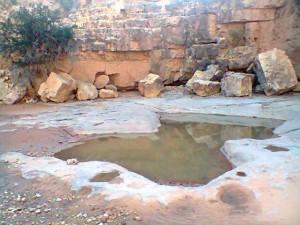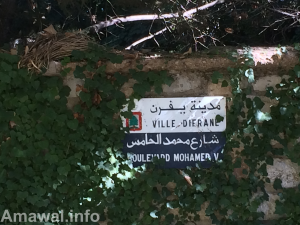This section AMAZIGH LETTERS is a collection of letters authored or collected by N Ashammakhi throughout years and gathered here to be in one collection and can be referred to in number of letter.
Letter 20080408a. Making negative of verbs
In Nafusa mountain (Adrar n infusan) and in Zwara of Libya, most of negative today is formed by either of the following means:
1. Wal +verb+sh
2. Wal+verb
3. Ammi+verb
4. Mosh+verb
The third and forth form are obviously Arabic in origin. Mosh is used in Taqrbust, Yefren.
Referring to the dialects, it seems that wal is also pronounced as war. One should recognize:
1. Conversion from “l” to “r” in dialects, e.g. Tarifit ? (1).
2. In the same dialect both forms may exist, i.e. “l” and “r” forms, but limited to some words
3. Confusion in hearing the words because of the very close proximity of “l” and “r” sound. This is made especially possible because of the lack of writing of Tamazight language (tutlayt Tamazight). For example, boshil (=boy) is pronounced with “l” in the end in Yefren while it is pronounced with “r” in the end in Zwara. Two such persons, one from Zwara and one from Yefren would unlikely recognize this unless brought to writing, and this is exactly what happened to me and a friend spoken to each other for more than 20 years.
The form “war” is also a part of some person names. This supports that the origin of “wal” is rather “war.”(1). Examples include: a) Wararni: “without victor”, i.e. nobody can conquer him. It is derived from the war (=without), and the noun arni (which means victor), in some Amazigh dialects such as Touareg. B) Warmaksan: “without enemy,” composed of war, and amaksan (=who hates; Ksen =hate in Touareg).
In conclusion, “Wal” form is the most probably the right original format and it can rather be “war” than “wal.”
References.
(1) Tawalt.com ?
(2) http://www.kabylia.info/observer/spip.php?article68 Accessed on April 8, 2008
Letter 20080408b: Amazigh words in Local Libyan/North African Arabic-Amazigh dialect(s)
Dehmani: Adehmani purple. See http://www.agraw.com/modules/wordbook/entry.php?entryID=238
Dukali: from “adukal” which means friend.
Mazwghi: from “imzwagh” which means reddish.
Zattaf: from “azattaf” which means black.
Fituri: from “Afitur” which means remains of olives after grinding during teh process of oil production.
Hawwari: From “hawwara,” a name of tribe.
Azwawi: From “zwawa,” a name of a tribe.
Karmos: from “akrmos” which means unripe fig(s).
Ghashshir: from “aghashshir” which means baby.
Zarwal: from “azarwal” which means blue.
Makraz: from “amkraz” which means farmer.
Snousi: from “Snous.” At Snous is an amazigh village in Algeria. Snous means little donkey.
Suf: from “asuf” which means vally.
Fakruna: from “tafakrunt”
Tajura: A town in northern Libya, c. 20 km east to Tripoli. from “tagura” which means departure or walking.
Jrana: from “ajru” which means “frog”.
Letter 20140924a كلمات مشتركة بين الأمازيغية واللاتينية
بعض الكلمات المشتركة بين الأمازيغية واللاتينية:
– أفلوس = ديك (ايضا في اللهجات شمال افريقية فلوس) (pullus)
– اسنوس = جحش (asinus)
– تافاريست = اجاصة (pirus)
– ئيكرigar= حقل (ager)
– ؤرتي= بستان (urti)
– ازبّوج = زيتونة برية (acerbus)
– اكارّوش= بلّوط (quereus)
المصدر:
مسار اللغة الامازيغية. الرهانات والاستراتيجيات. أحمد بوكوس. 2013، ص 75. (انظر 1920)- ء
Letter 20150930a
Words having the stem “gm/jm” or “gl” are related to fullness with water. E.g. Tagummimt” means mouthful (of water). “Ajimi” means field. In local Libyan language the word منقع is used to mean ajimi. This means place fills with water (collects water?). “Jmam” is ward used for describing a vessel full of liquid. “Agulmim” in Morocco. “Galta” in Local Libyan Language means small collection of water in the land (picture) is possible an arabization of the Tamazight word which can possibly be “taglt.” “Agallu” means waterfall.
(*) Picture Source (Facebook امازيغ ترهونة)
Letter 20151001a
Words “Asuf” of suf means vally. Asif means river. Asfi means estuary. Asfir means gutter. Substance “s+f” seem to be related to moving water.
Letter 20151003a
توجد في ليبيا مدينة اسمها يفرن. وفي المغرب كذلك. لكن شاع رسم الاسم في ليبيا هكذا “يفرن” وكثر استخدام “ايفران” في المغرب. ولقد ظننت انه قد يكون هناك اختلاف في الاسم، لكن رايت في احد شوارع يفرن “المغربية” رسم لها مثل شقيقتها الليبية “يفرن” (الصورة). لربما اذن صار رسمه بالعربية ايفران بعد كتابتها بالفرنسية
. (Ifrane)
اذا صحت الرواية فهي كلمة في صيغة جمع لمفرد هو “إيفري” بمعنى غار. ونظرا لان النطق الامازيغي لصوت الكسرة هو بين الهمزة المكسورة والياء وليس بأي منهما فقد كتبت بالياء مرة وبالهزة مرة وهي “يفران” أو “إفران” كلاهما صحيح مادام النطق واحد. وحتى يتم معياريتها بحروف تيفيناغ سنضل نرى رسم الكلمة بصور مختلفة
Letter 20151015a.
اسود هو ازطّاف (اسطاف في قاموس محمد شفيق) أو أبركان أو أبرشان أو أبخّان أو أبخّوش. نقول في ليبيا بالدارجة “برشني” وبالامازيغية “بُرشني” ونقصد الجدي. وكما نعلم فالجدي الوطني اسود اللون دائما ويبدو انها من “ابرشان” رغم ان الكلمة لاتستخدم الان لوصف الاسود في امازيغية إنفوسن. جدير بالذكر انه يوجد لقب أزطاف ولقب ابخيش في يفرن ليبيا. وابخيش يبدو انها تصغير لـ”أبخّوشّ”. ايضا يقول اللليبيون “بخشة”. ويقال “بخنوق” وبالامازيغية “تابحنوقت” وهوغطاء صوفي تضعه المراة على رأسها. ماعلاقته بالاسود؟ ما رأيته لونه احمر فهل تكون “تابحنوقت” أيضا سوداء؟
 (*)
(*)